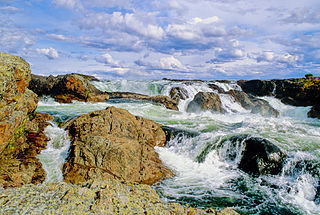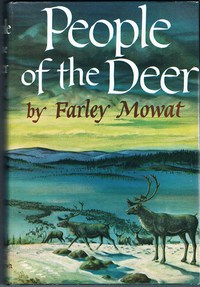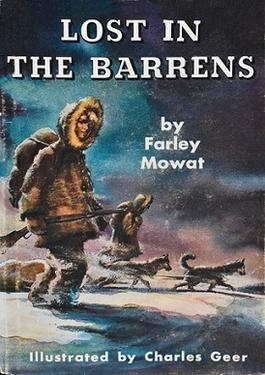Related Research Articles

Farley McGill Mowat, was a Canadian writer and environmentalist. His works were translated into 52 languages, and he sold more than 17 million books. He achieved fame with the publication of his books on the Canadian north, such as People of the Deer (1952) and Never Cry Wolf (1963). The latter, an account of his experiences with wolves in the Arctic, was made into a film of the same name released in 1983. For his body of work as a writer he won the annual Vicky Metcalf Award for Children's Literature in 1970.

Whale Cove, is a hamlet located 74 km (46 mi) south southwest of Rankin Inlet, 145 km (90 mi) northeast of Arviat, in the Kivalliq Region, Nunavut, Canada, on the western shore of Hudson Bay.

Ennadai Lake is a lake in the Kivalliq Region, Nunavut, Canada. It is 84 km (52 mi) long, and 4.8 to 22.5 km wide. It is drained to the north by the Kazan River. A 615 km (382 mi) section of the Kazan River from the outlet of Ennadai Lake to Baker Lake, was designated as a part of the Canadian Heritage Rivers System in 1990.

The Snow Walker is a 2003 Canadian survival drama film written and directed by Charles Martin Smith and starring Barry Pepper and Annabella Piugattuk. Based on the short story Walk Well, My Brother by Farley Mowat, the film is about a Canadian bush pilot whose life is changed through an encounter with a young Inuk woman and their challenge to survive the harsh conditions of the Northwest Territories following an aircraft crash. The film won six Leo Awards, including Best Lead Performance by a Male, and was nominated for nine Genie Awards, including Best Motion Picture, Best Performance by an Actor, Best Performance by an Actress, and Best Adapted Screenplay.

Never Cry Wolf is a 1983 American drama film directed by Carroll Ballard. The film is an adaptation of Farley Mowat's 1963 "subjective non-fiction" book. The film stars Charles Martin Smith as a government biologist sent into the wilderness to study the caribou population, whose decline is believed to be caused by wolves, even though no one has seen a wolf kill a caribou. The film also features Brian Dennehy and Zachary Ittimangnaq.

The Kazan River, is a Canadian Heritage River located in Nunavut, Canada. The Dene name for the river was Kasba-tue meaning "white partridge river." The name was apparently changed to Kazan in the late 19th century due to the influence of Order of Mary Immaculate missionaries. The river headwaters are in northern Saskatchewan at Kasba Lake, and it flows north for about 1,000 kilometres (620 mi) before emptying into Baker Lake, on the opposite side of the mouth of the Thelon River. Along its course the river flows through several lakes, including Ennadai Lake and Yathkyed Lake, over the Kazan Falls, down a red sandstone gorge and through both boreal forest and tundra. It is the last section of the river, below Ennadai Lake, that is above the timber line and is designated a Canadian Heritage River.

People of the Deer is Canadian author Farley Mowat's first book, and brought him literary recognition. The book is based upon a series of travels the author undertook in the Canadian barren lands, of the Keewatin Region, Northwest Territories (now the Kivalliq Region, Nunavut, west of Hudson Bay. The most important of these expeditions was in the winter of 1947–48. During his travels Mowat studied the lives of the Ihalmiut, a small population of Inuit, whose existence depended heavily on the large population of caribou in the region. Besides descriptions of nature and life in the Arctic, Mowat's book tells the sad story of how a once prosperous and widely dispersed people slowly dwindled to the brink of extinction due to unscrupulous economic interest and lack of understanding.
John "Jack" Howard Sissons was a Canadian barrister, author, judge and federal politician.
The Ahiarmiut ᐃᓴᓪᒥᐅᑦ or Ihalmiut or are a group of inland Inuit who lived along the banks of the Kazan River, Ennadai Lake, and Little Dubawnt Lake, as well as north of Thlewiaza River, in northern Canada's Keewatin Region of the Northwest Territories, now the Kivalliq Region of present-day Nunavut.
Henik Lake is located in the Kivalliq Region of Nunavut, Canada. The lake is made up of two lakes, North Henik Lake and South Henik Lake with a narrows separating them. Of the two, North Henik Lake is the smaller with an area of 245 km2 (95 sq mi), while South Henik Lake has an area of 513 km2 (198 sq mi).

Kivallirmiut, also called the Caribou Inuit, barren-ground caribou hunters, are Inuit who live west of Hudson Bay in Kivalliq Region, Nunavut, between 61° and 65° N and 90° and 102° W in Northern Canada.

Lost in the Barrens is a 1956 children's novel by Farley Mowat. Later editions used the title Two Against the North.

Killiniq is a former Inuit settlement, weather station, trading post, missionary post, fishing station, and Royal Canadian Mounted Police post on Killiniq Island. Previously within Labrador, and then the Northwest Territories, it is now situated within the borders of Nunavut. The community closed in 1978.
Padlei is a former community in the Kivalliq Region of Nunavut, Canada. It is located on the mainland on the north shore of Kinga (Kingarvalik) Lake at the juncture of the Maguse River. Whale Cove is to the east, while the Henik Lakes are to the southwest.

Uqqurmiut Centre for Arts & Crafts is an arts centre that was established by the Uqqurmiut Inuit Artists Association in 1990, in Pangnirtung, in the Qikiqtaaluk Region of Nunavut, Canada. The Centre includes a Tapestry Studio, a Craft Gallery, and a Print Shop. In spite of its remote location and small population, numerous Inuit from Pangnirtung have successfully marketed their prints, carvings, sculptures, and textile arts, such as woven wall hangings, to southern collectors. Starting in the 1970s, limited edition prints from the original Print Shop were published annually as the Pangnirtung Prints Collection through the then-Eskimo Co-operative. In 1970 a weaving studio was established and over time the tapestries attracted an international market.

The 1950 Canadian caribou famine happened when a change in caribou migration patterns caused widespread death in the southern interior of the District of Keewatin, Northwest Territories, now the Kivalliq Region, Nunavut, in the west of Canada's Hudson Bay. The resulting famine wiped out half of the impacted Caribou Inuit communities.
Janet Nungnik or Janet Anautalik Nungnik is an Inuk textile artist who lives and works in Qamani’tuaq, which is also known as Baker Lake, Nunavut, Canada. She is known for her colourful applique and embroidery works that display landscapes and everyday rural arctic life.
Elisapee Ootoova was an Inuit elder who preserved and promoted Inuit traditional knowledge.
Helen Agaaqtuq Konek is a Inuk elder from Arviat, Nunavut. A 1949 photograph of her went viral in 2019.
Kikkik is a Canadian television documentary film, directed by Ole Gjerstad and released in 2000. The film depicts the story of Kikkik, an Inuk woman who was placed on trial in 1958 for criminal negligence after killing her brother in self-defense when he tried to murder her, and then being forced to abandon some of her children when she travelled to the trading post at Padlei to obtain help.
References
- ↑ Damas, 2002
- ↑ "Remembering Kikkik". Nunatsiaq News , June 21, 2002.